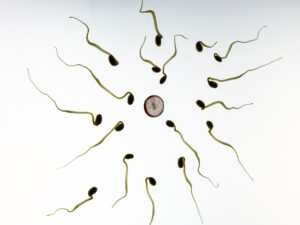Article contributed by Dr Peter Ng and Dr Beatrice Chua Yoong Ni
 The aim of a vasectomy is to prevent sperm from reaching the semen by disconnecting the sperm duct. The resulting ejaculate is therefore sperm-free, eliminating the risk of pregnancy. Sort of like a cheap shark fin soup without the shark fins (sperms).
The aim of a vasectomy is to prevent sperm from reaching the semen by disconnecting the sperm duct. The resulting ejaculate is therefore sperm-free, eliminating the risk of pregnancy. Sort of like a cheap shark fin soup without the shark fins (sperms).
Vasectomy is the contraception of choice for 6%–8% of married couples worldwide. Vasectomy is a minor procedure that provides effective and permanent contraception. In fact, it is far more effective than many other methods of contraception, including female sterilization.
 Prior to a vasectomy, it is important and both husband and wife be present together to be counseled by a specialist on the implications of the procedure. It is important that the completeness of family is ascertained and that both husband and wife had discussed beforehand and agreed that it is the husband who should undergo a vasectomy to attain permanent contraception.
Prior to a vasectomy, it is important and both husband and wife be present together to be counseled by a specialist on the implications of the procedure. It is important that the completeness of family is ascertained and that both husband and wife had discussed beforehand and agreed that it is the husband who should undergo a vasectomy to attain permanent contraception.
 A vasectomy typically takes 20-30 minutes and is done under local anaesthesia (LA) with or without sedation or under general anaesthesia if the patient is squeamish about pain. After LA is administered, a small nick is done on the scrotum. The sperm duct or vas deferens is exposed and cut with 1-2cm of the duct removed. Then, the ends will be diathermized (using heat to destroy tissue) to close the channel of the duct and they will be bent upon itself and tied. After that, the two tied ends are buried in different tissue planes to reduce the chances of them rejoining.
A vasectomy typically takes 20-30 minutes and is done under local anaesthesia (LA) with or without sedation or under general anaesthesia if the patient is squeamish about pain. After LA is administered, a small nick is done on the scrotum. The sperm duct or vas deferens is exposed and cut with 1-2cm of the duct removed. Then, the ends will be diathermized (using heat to destroy tissue) to close the channel of the duct and they will be bent upon itself and tied. After that, the two tied ends are buried in different tissue planes to reduce the chances of them rejoining.
 After a vasectomy, patients should take plenty of fluids as well as take the pain killers provided. He should rest at home, limit activity, and wear a scrotal support for the next 48 hours. He must see his urologist if there is any pain or swelling of the scrotum or fever.
After a vasectomy, patients should take plenty of fluids as well as take the pain killers provided. He should rest at home, limit activity, and wear a scrotal support for the next 48 hours. He must see his urologist if there is any pain or swelling of the scrotum or fever.
It is important to note that vasectomy does not provide immediate sterility! It is important to use another form of contraception until after occlusion of vas is confirmed by the absence of sperms or rare non-motile sperm on post-vasectomy semen analysis done at 8 to 16 weeks or after 25 ejaculations after the surgery. Patients should refrain from ejaculation for approximately one week after vasectomy.
Some short-term surgical complications are 1-2% risk of blood clot formation, and infection. On the other hand, the most common long-term complication of a vasectomy is chronic scrotal pain that affects 1-2% of men. The risk of pregnancy after a vasectomy is 1 in 2000 for men who have post-vasectomy azoospermia which is caused by spontaneous re-canalization of the sperm duct.
 Around 3-6% of men who have undergone vasectomy may opt for a reversal later in life for various reasons. Unlike vasectomy, a vasectomy reversal is a procedure that is much more technically challenging, requiring the use of an operating microscope. In addition to this, the result of vasectomy reversals after 10 years is poor at about 39%. Besides vasectomy reversal, other options for fertility after vasectomy include sperm retrieval with in vitro fertilization. These options are not only expensive, but they also may not always be successful. Hence, pre-vasectomy counseling is of utmost importance.
Around 3-6% of men who have undergone vasectomy may opt for a reversal later in life for various reasons. Unlike vasectomy, a vasectomy reversal is a procedure that is much more technically challenging, requiring the use of an operating microscope. In addition to this, the result of vasectomy reversals after 10 years is poor at about 39%. Besides vasectomy reversal, other options for fertility after vasectomy include sperm retrieval with in vitro fertilization. These options are not only expensive, but they also may not always be successful. Hence, pre-vasectomy counseling is of utmost importance.
Article contributed and written by
Dr Peter Ng (Consultant Urologist)
Dr Beatrice Chua Yoong Ni
Subang Jaya Medical Centre
References and further reading:
https://www.urologyhealth.org/urology-a-z/v/vasectomy
https://www.auanet.org/guidelines/vasectomy-guideline
https://theconversation.com/explainer-how-does-a-vasectomy-work-and-can-it-be-reversed-110780
https://www.ncbi.nlm.nih.gov/pmc/articles/PMC4854082/
To print a pdf copy, click HERE
[mailerlite_form form_id=3]

